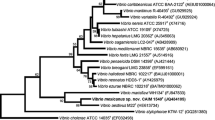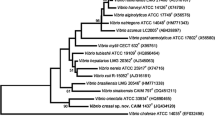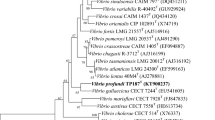Abstract
Strain CAIM 1076T was isolated from a cultured oyster Crassostrea gigas in Puerto Peñasco, Sonora state, México. The strain was taxonomically characterised by means of a genomic approach, comprising 16S rRNA gene sequence analysis, multilocus sequence analysis (MLSA), the DNA G+C content and whole genome analyses (ANI and GGDC), and by phenotypic characterisation. Strain CAIM 1076T was found to be catalase and oxidase positive, and cells were observed to be motile and facultative anaerobic. Analysis of the almost-complete 16S rRNA gene sequence placed this strain within the genus Vibrio; closely related species were Vibrio maritimus, Vibrio variabilis, Vibrio proteolyticus, and Vibrio nigripulchritudo with similarity values of 98.9, 98.5, 98.1, and 98.0 %, respectively. MLSA of six housekeeping genes (ftsZ, gapA, gyrB, recA, rpoA and topA) was performed with the closely related species. A draft genome sequence of strain CAIM 1076T was obtained. The DNA G+C content of this strain was determined to be 44.5 mol %. The genomic similarity values with V. maritimus were 71.6 % (ANIb), 85.1 % (ANIm) and a GGDC value of 20.3 ± 2.3 %; with V. variabilis the genomic similarities were 71.8 % (ANIb), 85.4 % (ANIm) and 20.0 ± 2.3 % (GGDC); with V. proteolyticus, 71.6 % (ANIb), 84.1 % (ANIm) and 18.8 ± 2.2 % (GGDC); and with V. nigripulchritudo, 70.8 % (ANIb), 84.9 % (ANIm) and 20.5 ± 2.3 % (GGDC). These ANI and GGDC values are below the thresholds for the delimitation of prokaryotic species, i.e., 95–96 and 70 %, respectively. Phenotypic characters also showed differences with the closely related species analysed. The results presented here support the description of a novel species, for which the name Vibrio sonorensis sp. nov. is proposed, with strain CAIM 1076T (=CECT 9100T, =DSM 102190T) as the type strain.

Similar content being viewed by others
Abbreviations
- ANI:
-
Average nucleotide identity
- GGDC:
-
Genome-to-genome distance calculator
- MLSA:
-
Multilocus sequence analysis
References
Amaral GRS, Dias GM, Wellington-Oguri M, Chimetto L, Campeão ME, Thompson FL, Thompson CC (2014) Genotype to phenotype: identification of diagnostic vibrio phenotypes using whole genome sequences. Int J Syst Evol Microbiol 64:357–365
Auch AF, von Jan M, Klenk H-P, Göker M (2010) Digital DNA–DNA hybridization for microbial species delineation by means of genome-to-genome sequence comparison. Stand Genom Sci 2:117–134
Aziz RK, Bartels D, Best AA, DeJongh M, Disz T, Edwards RA, Formsma K, Gerdes S, Glass EM, Kubal M, Meyer F, Olsen GJ, Olson R, Osterman AL, Overbeek RA, McNeil LK, Paarmann D, Paczian T, Parrello B, Pusch GD, Reich C, Stevens R, Vassieva O, Vonstein V, Wilke A, Zagnitko O (2008) The RAST server: rapid annotations using subsystems technology. BMC Genom 9:75
Cano-Gomez A, Goulden EF, Owens L, Høj L (2010) Vibrio owensii sp. nov., isolated from cultured crustaceans in Australia. FEMS Microbiol Lett 302:175–181
Denner EBM, Vybiral D, Fischer UR, Velimirov B, Busse HJ (2002) Vibrio calviensis sp. nov., a halophilic, facultatively oligotrophic 0.2 m-filterable marine bacterium. Int J Syst Evol Microbiol 52:549–553
Faury N, Saulnier D, Thompson FL, Gay M, Swings J, Le Roux F (2004) Vibrio crassostreae sp. nov., isolated from the haemolymph of oysters (Crassostrea gigas). Int J Syst Evol Microbiol 54:2137–2140
González-Castillo A, Balboa S, Romalde JL, Gomez-Gil B (2014) Vibrio crosai sp. nov., isolated from a cultured oyster Crassostrea gigas. Antonie Van Leeuwenhoek 106:457–463
González-Castillo A, Enciso-Ibarra J, Bolán-Mejia MC, Balboa S, Lasa A, Romalde JL, Cabanillas-Beltrán Gomez-Gil B (2015) Vibrio mexicanus sp. nov., isolated from a cultured oyster Crassostrea corteziensis. Antonie Van Leeuwenhoek 108:355–364
Henz S, Huson D, Auch AF, Nieselt-Struwe K, Schuster S (2005) Whole-genome prokaryotic phylogeny. Bioinformatics 21:2329–2335
Huson DH, Bryant D (2006) Application of phylogenetic networks in evolutionary studies. Mol Biol Evol 23:254–267
Kim OS, Cho YJ, Lee K, Yoon SH, Kim M, Na H, Park SC, Jeon YS, Lee JH, Yi H, Won S, Chun J (2012) Introducing EzTaxon-e: a prokaryotic 16S rRNA Gene sequence database with phylotypes that represent uncultured species. Int J Syst Evol Microbiol 62:716–721
Le Roux F, Goubet A, Thompson FL, Faury N, Gay M, Swings J, Saulnier D (2005) Vibrio gigantis sp. nov., isolated from the haemolymph of cultured oysters (Crassostrea gigas). Int J Syst Evol Microbiol 55:2251–2255
Lee I, Kim YO, Park SC, Chun J (2015) OrthoANI: an improved algorithm and software for calculating average nucleotide identity. Int J Syst Evol Microbiol 66:1100–1103
Ludwig W, Klenk HP (2000) Overview: a phylogenetic backbone and taxonomic framework for prokaryotic systematics. In: Boone DR, Castenholz RW, Garrity GM (eds) Bergey’s manual of systematic bacteriology, vol 1, 2nd edn. Springer, New York, pp 49–65
MacFaddin JF (1993) Pruebas bioquímicas para la identificación de bacterias de importancia clínica (translation by Médica Panamericana SA). Williams & Wilkins, Baltimore
Macián MC, Ludwig W, Aznar R, Grimont P, Schleifer KH, Garay E, Pujalte MJ (2001) Vibrio lentus sp. nov., isolated from Mediterranean oysters. Int J Syst Evol Microbiol 51:1449–1456
Meier-Kolthoff JP, Alexander AF, Hans-Peter K, Markus K (2013) Genome sequence-based species delimitation with confidence intervals and improved distance functions. BMC Bioinform 14:60
Moreira AP, Pereira N Jr, Thompson FL (2011) Usefulness of a real-time PCR platform for G+C content and DNA–DNA hybridization estimations in vibrios. Int J Syst Evol Microbiol 61:2379–2383
Moreira AP, Duytschaever G, Chimetto TLA, Dias GM, Mesquita Cnockaert M, Francini-Filho RB, DeVos P, Thompson CC, Thompson FL (2014) Vibrio madracius sp. nov. isolated from Madracis decactis (Scleractinia) in St. Peter & St. Paul Archipelago, Mid-Atlantic Ridge, Brazil. Curr Microbiol 69:405–411
Noguerola I, Blanch AR (2008) Identification of Vibrio spp. with a set of dichotomous keys. J Appl Microbiol 105:175–185
Oren A (2004) Prokaryote diversity and taxonomy: current status and future challenges. Philos Trans R Soc Lond B 359:623–638
Parker CT, Tindall BJ, Garrity GM (2015) International code of nomenclature of prokaryotes. Int J Syst Evol Microbiol. doi:10.1099/ijsem.0.000778
Pascual J, Macián MC, Arahal DR, Garay E, Pujalte MJ (2010) Multilocus sequence analysis of the central clade of the genus Vibrio by using the 16S rRNA, recA, pyrH, rpoD, gyrB, rctB and toxR genes. Int J Syst Evol Microbiol 60:154–165
Prado S, Romalde JL, Montes J, Barja JL (2005) Pathogenic bacteria isolated from disease outbreaks in shellfish hatcheries. First description of Vibrio neptunius as an oyster pathogen. Dis Aquat Org 67:209–215
Prado S, Romalde JL, Barja JL, Toranzo AE (2014) Vibrio ostreicida sp. nov., a new pathogen for bivalve larvae. Int J Syst Evol Microbiol 64:1641–1646
Quail MA, Smith M, Coupland P, Otto TD, Harris SR, Connor TR, Bertoni A, Swerdlow HP, Gu Y (2012) A tale of three next generation sequencing platforms: comparison of Ion Torrent, Pacific Biosciences and Illumina MiSeq sequencers. BMC Genom 13:341
Reydon TAC (2004) Why does the species problem still persist? BioEssays 26:300–305
Richter M, Rosselló-Móra R (2009) Shifting the genomic gold standard for the prokaryotic species definition. Proc Natl Acad Sci USA 106:19126–19131
Sasser M (1990) Identification of bacteria by gas chromatography of cellular fatty acids. Microbial ID Inc, Newark
Sawabe T, Kita-Tsukamoto K, Thompson FL (2007) Inferring the evolutionary history of vibrios by means of multilocus sequence analysis. J Bacteriol 189:7932–7936
Sawabe T, Ogura Y, Matsumura Y, Feng G, Rohul Amin AKM, Mino S, Nakagawa S, Sawabe T, Kumar R, Fukui Y, Satomi M, Matsushima R, Thompson FL, Gomez-Gil B, Christen R, Maruyama F, Kurokawa K, Hayashi T (2013) Updating the Vibrio clades defined by multilocus sequence phylogeny: proposal of eight new clades, and the description of Vibrio tritonius sp. nov. Front Microbiol 4:1–14
Sutcliffe IC, Trujillo ME, Goodfellow M (2012) A call to arms for systematists: revitalising the purpose and practises underpinning the description of novel microbial taxa. Antonie Van Leeuwenhoek 101:13–20
Tamura K, Peterson D, Peterson N, Stecher G, Nei M, Kumar S (2011) MEGA5: molecular evolutionary genetics analysis using maximum likelihood, evolutionary distance, and maximum parsimony methods. Mol Biol Evol 28:2731–2739
Tarazona E, Lucena T, Arahal DR, Macián MC, Ruvira MA, Pujalte MJ (2014) Multilocus sequence analysis of putative Vibrio mediterranei strains and description of Vibrio thalassae sp. nov. Syst Appl Microbiol 37:320–328
Thompson FL, Thompson CC, Li Y, Gomez-Gil B, Vandenberghe J, Hoste B, Swings J (2003) Vibrio kanaloae sp. nov., Vibrio pomeroyi sp. nov. and Vibrio chagasii sp. nov., from sea water and marine animals. Int J Syst Evol Microbiol 53:753–759
Thompson CC, Chimetto L, Edwards RA, Swings J, Stackebrandt E, Thompson FL (2013) Microbial genomic taxonomy. BMC Genom 14:913
Thompson CC, Amaral GR, Campeão M, Edwards RA, Polz MF, Dutilh BE, Ussery DW, Sawabe T, Swings J, Thompson FL (2015) Microbial taxonomy in the post-genomic era: rebuilding from scratch? Arch Microbiol 197:359–370
Tison DL, Seidler RJ (1983) Vibrio aestuarianus: a new species from estuarine waters and shellfish. Int J Syst Bacteriol 33:699–702
Vandamme P, Peeters C (2014) Time to revisit polyphasic taxonomy. Antonie Van Leeuwenhoek 106:57–65
Vesth T, Lagesen K, Acar O, Ussery D (2013) CMG-biotools, a free workbench for basic comparative microbial genomics. PLoS One 8:e60120
Acknowledgments
This work was partially funded by CONACYT project CB-2009-01 132328.
Author information
Authors and Affiliations
Corresponding author
Electronic supplementary material
Below is the link to the electronic supplementary material.
Rights and permissions
About this article
Cite this article
González-Castillo, A., Enciso-Ibarra, J., Dubert, J. et al. Vibrio sonorensis sp. nov. isolated from a cultured oyster Crassostrea gigas . Antonie van Leeuwenhoek 109, 1447–1455 (2016). https://doi.org/10.1007/s10482-016-0744-z
Received:
Accepted:
Published:
Issue Date:
DOI: https://doi.org/10.1007/s10482-016-0744-z




